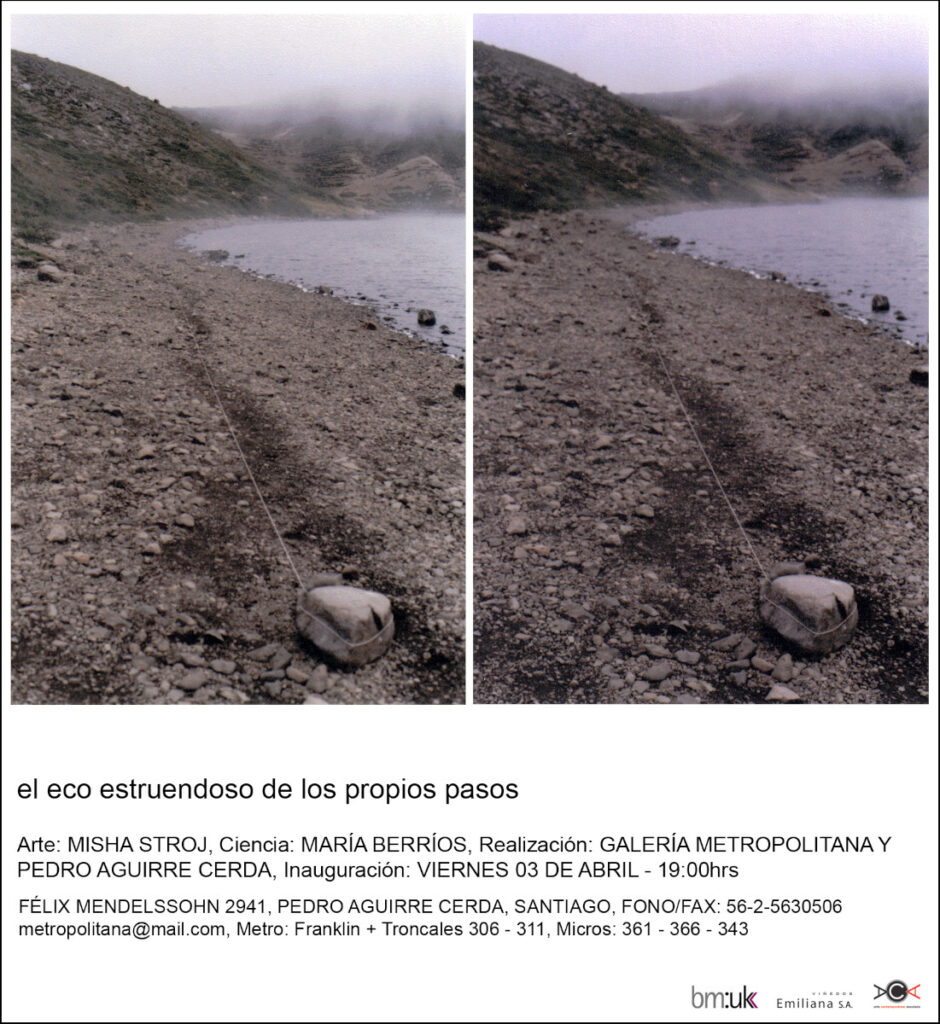
[2] Our collaborator, partners and lenders were: Juan Aguilera (wicker-artisan), Antonio Alarcón (student); Humberto Arcos (The Postman), Victor Atal Nasser (poster artist), Luis Canales (metalworker), Mrs. Maria Castro (domestic installations) ; Juan Patricio Garrido Carte (bulrush weaver), Hector Carreño (master welder), Juan Cayuqueo (student), Ricardo Cea and family (mannequins) Lorenzo Contreras (ceramist), Julio Cuevas (Folklorist, adobe donation), Hernan Diaz González (plumber-inventor); Domingo Duran (carpenter, wood-crafts), Pedro Escobar (cabinet maker), Georgina Escobar (seamstress specializing in embroidery), Ricardo Esquivel (ironworker master and lord of the birds), Ignacio Gumucio (painter) Carlos Gutierrez (blacksmith), Mario Herrera Santibanez (glass artisan), Jose Miguel Huerta (construction and glass), Alexandro Lueiza (stained glass), Francoise Maurice (the mastermind on staircases), Ms. Margarita Ogaz (textile painting, Magallanes Senior Citizens Club), John Oyarce (tinsmith), Jose Parada (photography research), Yasmine Riveros Soto (student), Ms. Mary Raimilla (pihuio cerramics) and Maite Evelyn Bascur Valdés (seamstress) Batea Pehuenche (Private Collection of Rodrigo Berrios), Ricardo Cea, Claudio Matte, Bust, 2008 (Artists Collection), Carlos Ortúzar, Estante, 1958. (Private Collection of Pedro Escobar); Bird’s bath stone, (Private Collection of Ana María Saavedra and Luis Alarcón); Asphalt piece(Private Collection of José Parada).

Pa’ onde vamos (Wea do we go) / 2009 / acrylic on billboard / ap. 500 x 250 cm / Show: el eco estruendoso de los proprios pasos (The roaring Echo of the Steps of your Own) / 03.04. 15.05.2009 / Galería Metropolitana, Santiago de Chile
(…) The intentional exposure to a foreign language can have a regressive effect the return to a state of communicational incompetence but it is also potentially emancipating: nothing is taken for granted. Given the awkwardness and naivete caused by the attempt to navigate the new words of the unknown language, Stroj takes the opportunity to go back to being a neophyte, extending his formula for (language) learning into a formula for (sculpture) production. This is not literal or metaphorical, but potentially practical. ” (María Berríos)

La masquera (The Masque) / 2009 / MDF, pieces of glass, string / Various dimensions
The roaring echo of the steps of your own is the title of a truly invigorating experience in a workingclass neighborhood in Santiago de Chile. There, the Galería Metropolitana offers the opportunity to contribute to an environment quite unusual in the context of South American art world customs. Together with the sociologist, now curator, María Berríos, an intense experimental situation was created. The possible sculptural nature of any so called research work should be developed and explored. After historical lessons (see publication: El Cuaderno Verde) and a few trips across the country, the attention was fully focused on the inhabitants of the area around the exhibition site: the dear neighbours, all work was generated in exchange with them, or better: was made by them.
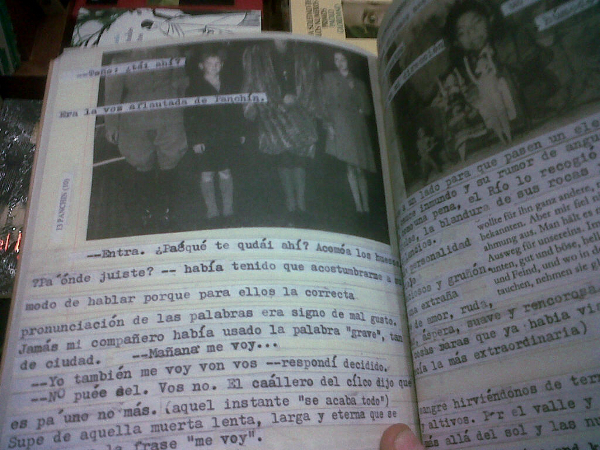
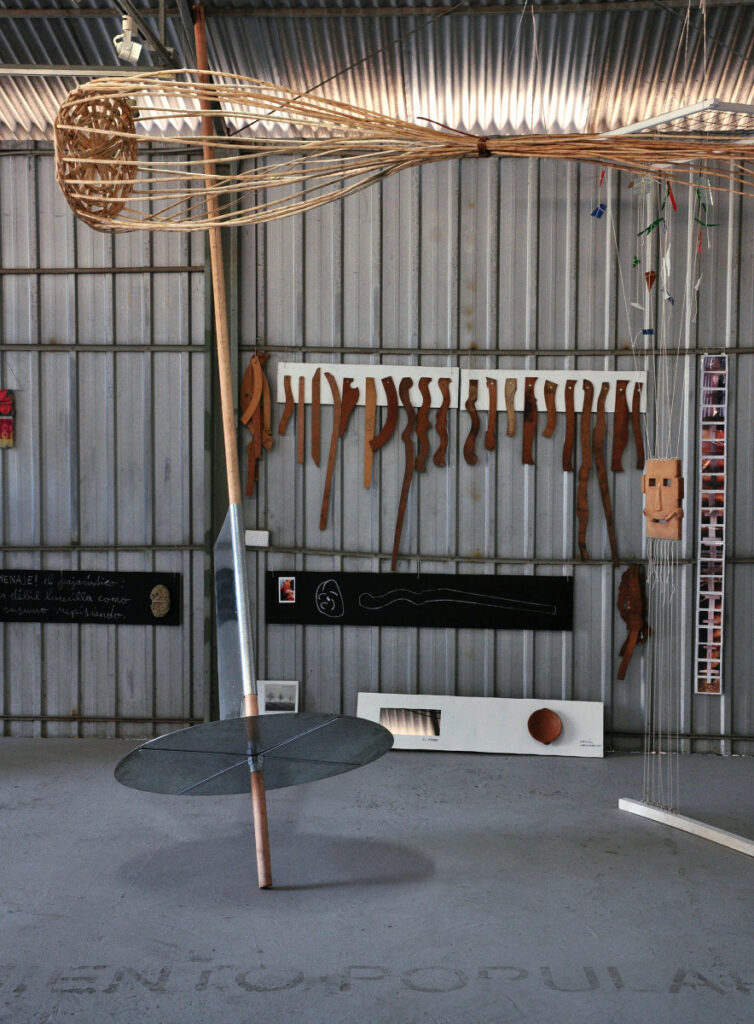
An unusual dynamic developed between the scientist, the (often) artisans of the neighborhood and the artist, who first became acquainted with the Spanish language. Thus the communication, the conversation, and finally the exchange about the production of things became the driving forces. The Cuaderno Verde became a kind of log book an inexhaustible source of sculptural questions. We wanted to try a different kind of exhibition making, getting as close as possible to the way people make things. In doing so, we combined our often awkward language of sculpture with the mostly elegant language of various crafts. Nothing less than watching the making of the world seemed to happen to us.
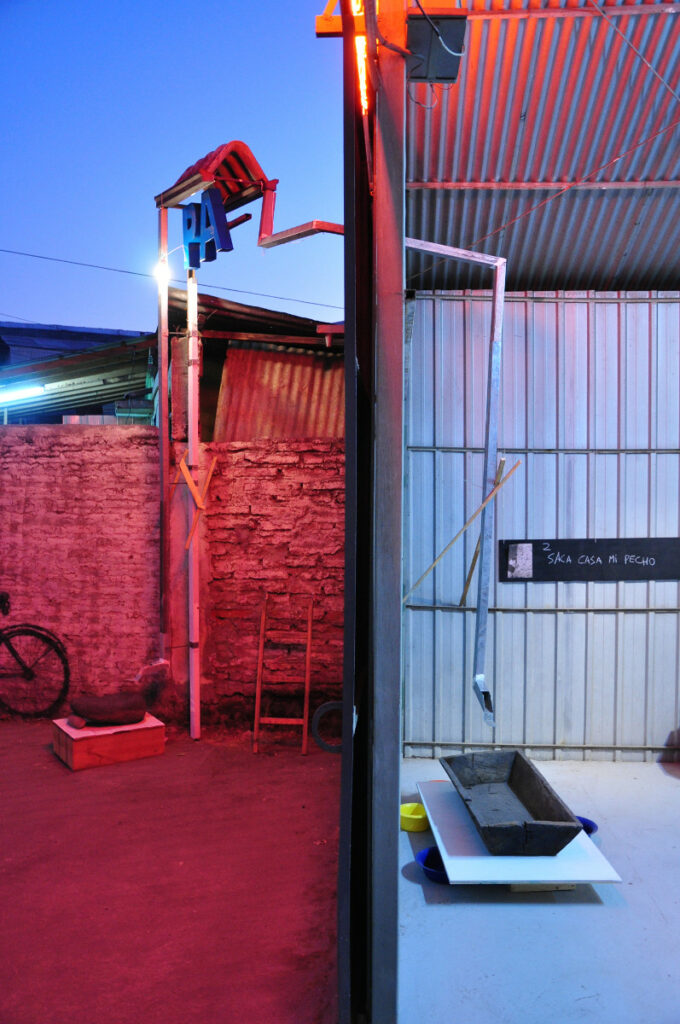
Pa (Wea) / 2009 / metal, roof, gutter, wood, plastic, vulcan stone / Various dimensions / Show: el eco estruendoso de los proprios pasos (The roaring Echo of the Steps of your Own) / 03.04. 15.05.2009 / Galería Metropolitana, Santiago de Chile
Individual works or their parts were developed with the help of various people in the neighborhood. Blurring and misunderstanding were often more helpful than precise guidelines. On the billboard outside the gallery, a quotation from the artist’s leitmotif was presented to the neighborhood. The book El Rio (by Alfredo Gómez Morel) reports on experiences on the margins of society dialogues are written in a rather crude dialect, revealing the social layer: “Where are we going? We can not stay here.” The text was written by a professional (neighbour), illustrated with a figure balancing dear planet earth. Part of the “where” in this quote, the “pa” was placed in front of the gallery (next door pan / bread is made). On the roof of the word fragment gutters are attached, the water collected by one cools a volcanic stone outside, the harvest from the other leads to indoors, where a tub made from a single tree trunk (work of indigenous people from the collection of a participant) waits for the rainwater. And rain in the summer of Santiago is a rare event.
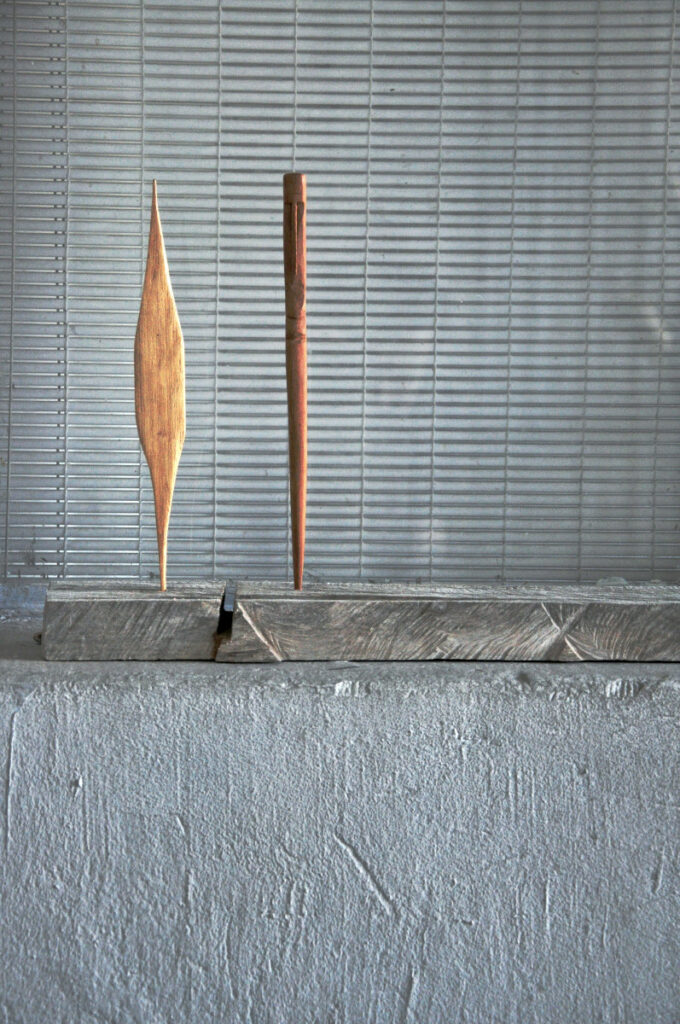
Miguelitos / 2009 / woodcarving / 17 x 2 x 0,2 + 17,5 x 0,8 x 0,4 cm / Show: el eco estruendoso de los proprios pasos (The roaring Echo of the Steps of your Own) / 03.04. 15.05.2009 / Galería Metropolitana, Santiago de Chile
With 42 tasks we started in search of expressions, went to find the people who could contribute through existing interests and skills. Ultimately, enthusiasm of the person determines the task, or interests and skills prove to be a vast field So passionate amateurs as well as actually skilled craftsmen were made complicit. The desire and curiosity of spoken language helped to come closer. Whereby emphasizing the limits of any need to what they call policies of integration, kept each other’s lust for… ja, lust for whatever you may put here. Also, the urge to produce and produce was more or less consciously questioned.
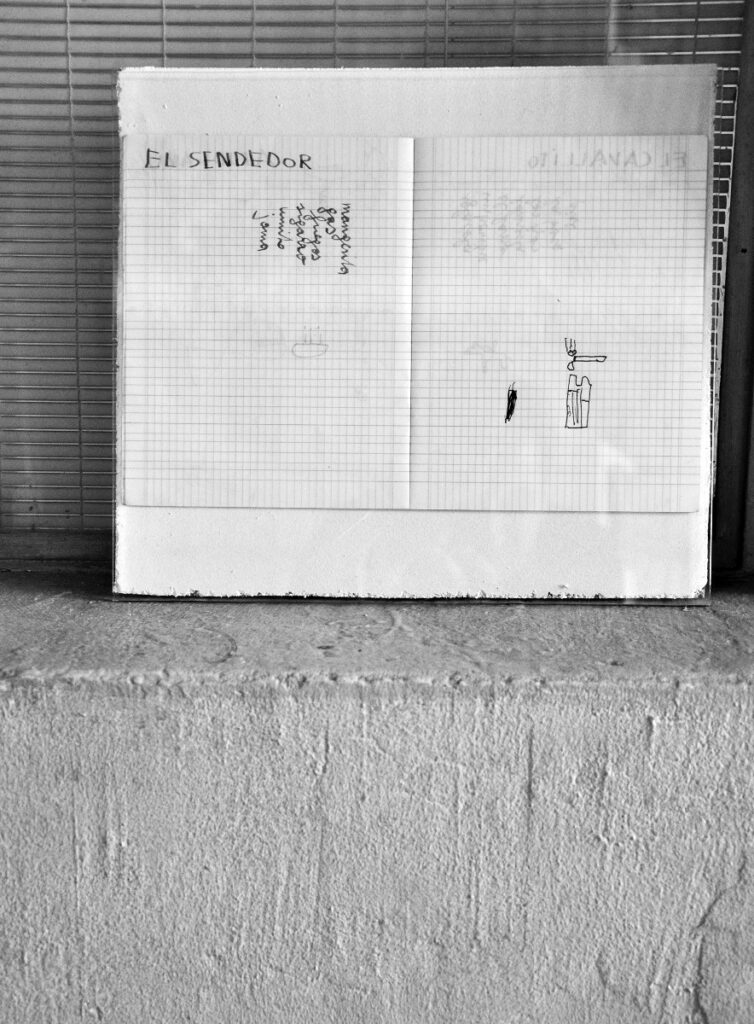
El sendedor (The Lighter) / 2009 / ink in exercise book / 32 x 24 cm / Show: el eco estruendoso de los proprios pasos (The roaring Echo of the Steps of your Own) / 03.04. 15.05.2009 / Galería Metropolitana, Santiago de Chile
A curtain of fire, to name one, was one of the visions. It was realized on three levels: the name in embroidered form, sculpturally, which in turn served as a pedestal for the moment of painting’s reinvention: after long planning of an actually burning in true flames variant, the installer’s safety concerns prevailed, he finally provided a curtainlike designed mechanism that only had to be completed by the painter with that what “pretends to be a fire”.
The overall installation was naturally dense, wildly proliferating and versatile. Last but not least, a painting of a locally established artist was discovered in the workshop of the neighboring carpenter (revealing the name of the painter ORTUZAR from behind). We were not alone.
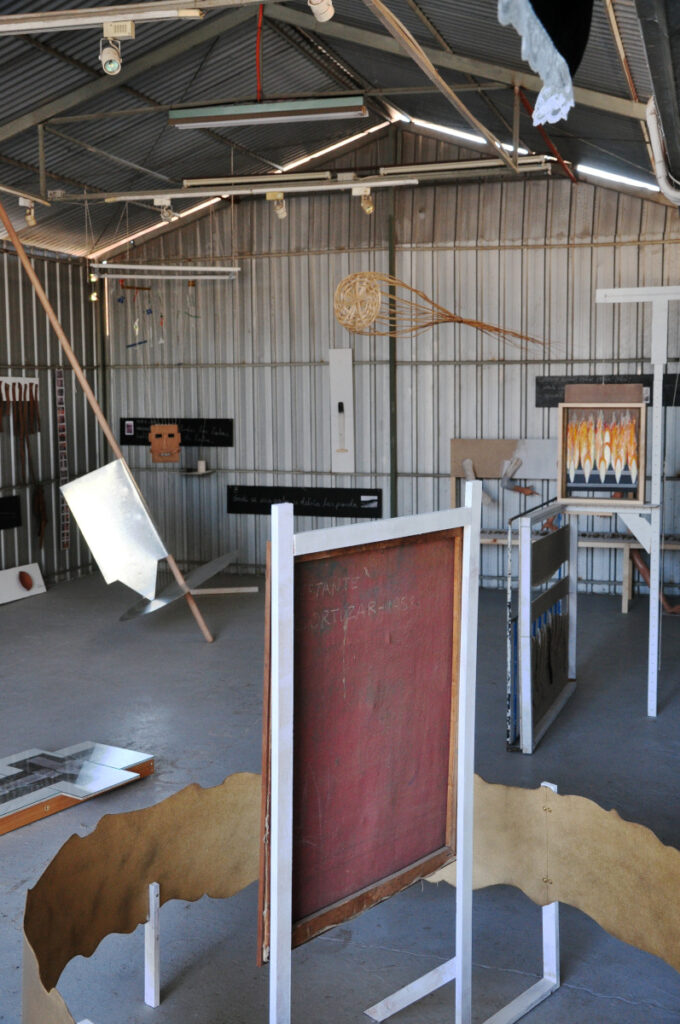
el eco estruendoso de los proprios pasos (The roaring Echo of the Steps of your Own) / 2009 / Show: el eco estruendoso de los proprios pasos (The roaring Echo of the Steps of your Own) / 03.04. 15.05.2009 / Galería Metropolitana, Santiago de Chile
Echolalia of an Echopraxia
o That Bridge That Is a Window
María Berríos
We wanted to rid ourselves of the classical ambitions of exhibitions making through inventing a way of approaching the strange language of sculpture. Although, perhaps, we simply wanted an excuse for getting closer to the way people make things. El eco estruendoso de los propios pasos (The thunderous echo of your own steps) was an effort to understand the clumsy but efficient language of sculpture, while at the same time comprehend the elegant language of craft. In sum, it was a way of observing how people manufacture their world.
El eco estruendoso de los propios pasos was an experiment in sculpture as research in the provisional format of an art exhibition.It consisted in the materialization, in the Galería Metropolitana space, of the lessons learned (from January to April 2009) in a series of inquiries on the sculptureness of research.The investigation that led to the exhibition was a joint venture by artist Misha Stroj, specialized in identifying and producing sculptural phenomena (Director of the Art Department of “El Eco …”) and the author of the present text, a sociologist, in charge of the fieldwork aimed at provoking the collision of shared sculptural knowledge (Director of the Scientific Department of “El Eco ….”)
After an intense but relatively brief journey of the physical,literary and visual, territory of Chile, we sought to develop a working method that would make possible desired encounters (while immediately admitting and taking advantage of all the obvious misunderstandings). Encounters between the artist passing by this remote terrain, the sociologist interested in exploring a qualitative-concretista methodology, and the neighbors-producers of the Pedro Aguirre Cerda (PAC) sector, home of our hosts at Galería Metropolitana.
The initial plot of the exhibition was developed in a green notebook prepared by the art department from materials collected in the research process .The field notes were sorted into the notebook through a formulation of forty chapters, a void and an alternative ending, each corresponding to a specific sculptural problem [1] .
Early on we recognized the need for the neighbors help as experts and creators of the existing systems of production being used in the PAC area.For this the plot of the exhibition was translated into a precise list of practical problems to be solved (…)
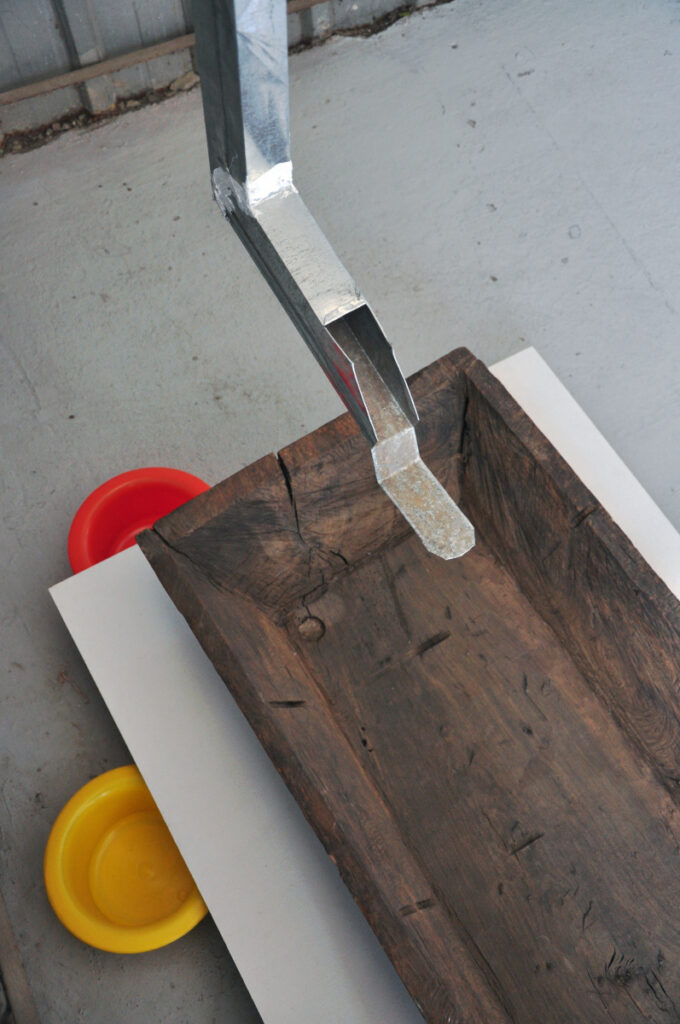
In our joint search for solutions to these 40 +2 problems ,we proceeded to visit the workshops of people making things nearby the Gallery (bulrush weavers, a stained glass master, tinkers, a plumber-inventor, a carpenter fond of masks, a wicker-basket maker, embroiderers, seamstresses, a pottery studio, a photographer, a master of glass miniatures , cabinet makers, a family run plaster mannequin factory, the mailman, Francois Maurice -whose name says it all- and many equally important others). So we came to know the many colleagues whose collaboration would be the foundation and productive base for the sculpture show to be assembled by the art department in the gallery space [2] .The people we visited and their works were responsible for the material that made up the collective show (disguised as a solo exhibition by an artist named Misha Stroj [3] ).Although the activation of sculpture did no take place in the fantasy of the exhibition installation in itself, but emerged in the materiality of the events of exchange where through our semi-handicapped words [4] we tried to mobilize the sculptural knowledge of others.
Our goals were, we agree, openly naive and outlandish: we wanted to create significant encounters based on the language of practice. The scale (semi-industrial, craft, literal, domestic or poetic) was not of importance;the sculptureness of research lay in our sneaking onto the privileged pedestal of sharing the language of making things (gutters, golf-pants for artists, stairs, curtains of fire, bird baths, matches …). This not so much in order to adapt to this more and less foreign context, but rather to articulate the desire of turning it into a more familiar place. We wanted to create tools that would allow us to discretely get close to those new places (… a small roof, a store sign, a stick collection, a golden crown, a horse’s tail, and so on).
[1] See: Misha Stroj, Cuaderno verde, ediciones vaticanochico-Ocho Libros, Santiago, 2010.
[3] This format did not fool the neighbors who while visiting the exhibition pointed out: “these are made by the Cea family”,”this is Domingo’s”,”those are my pieces of broken glass” and even one or two who retrieved their borrowed objects when needed (as was the case of the carpenter molds kindly lent to us by don Pedro).
[4] With this we are pointing at “the efficiency of clumsiness as language.”Which at the time we tried to explain as follows: “The artist talks about, and assists in the production of various objects, creating relationships based on mutual provocation and movement of curiosity. The intentional exposure to a foreign language can have a regressive effect -the return to a state of communicational incompetence- but it is also potentially productive: nothing is taken for granted thus intensifying the relationship with the language of things. Given the awkwardness and naivete caused by the attempt to navigate the new words of the unknown language, Stroj takes the opportunity to go back to being a neophyte, extending his formula for (language) learning into a formula for (sculpture) production. This with the aim of articulating a language, that is not literal or metaphorical, but potentially practical.
































